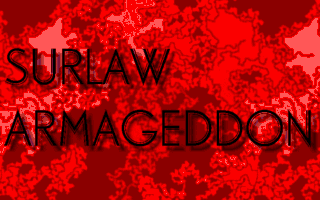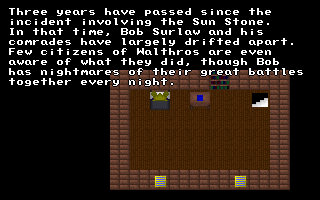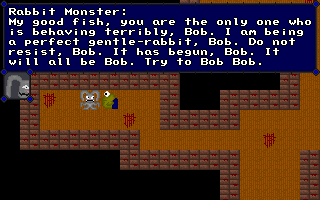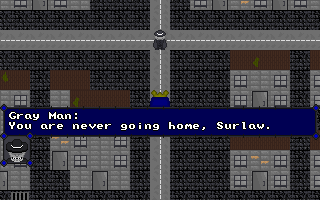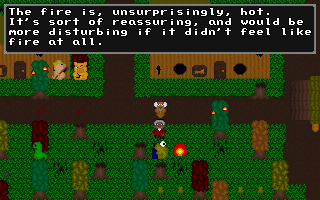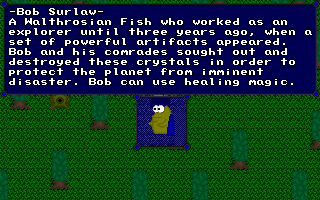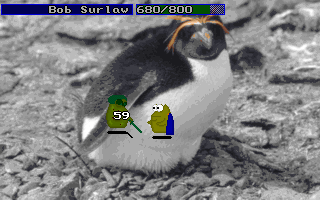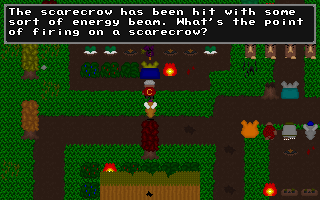Surlaw Armageddon begins with a backstory: a backstory that covers four
games, a comic, and a fistful of sidewinders. The games are iconic;
most of us know those of which many have played. The comic, less
publicized, endures in the shadows of time. But all have lived in a
hurricane of madness: the mind of one Paul Harrington.
At the eye of this storm, a Walthrosian fish remains in constant
motion, permanently fixed to the chaos around him. He runs into
shrines, tangles with walruses, and loves a good jog in the morning.
His battles have become folklore and his name, legend. And his legacy
has carried him through time. He has encountered many creatures,
gambled with his life, and fought against criticism of bad graphics.
And at the pinnacle of fame he's flirted with reality and
saved money on car insurance by switching to Geico.
His name is Bob Surlaw.
And this is his greatest chapter.
(For a full history, read the “readme” that comes
with the game.)
The Story:
His story begins with quotes from singers, set to the backdrop of
heavily dystopian music.
Then he awakes from his routine train of nightmares to find that
something in the world has changed. Steeling the pit of his stomach, he
hovers downstairs to discover his hallway has transformed into someone
else's hallway, and that someone else is nowhere to be found.
But amidst the plentiful smatterings of blood, he encounters a rabbit
monster who calls him by name constantly, who insists that they
converse regularly, though Surlaw has never seen him.
According to his momentary acid trip at the hands of this rabbit
monster, and according to the penguin god Penguingo, who cuts into his
delusion, Bob Surlaw is on the edge of death.
But death is not the answer for this adventure-hardened hero who takes
his awakening into surreality like a man...er, fish, by doing what he
does best: Encountering beasts and slaying them, all while asking a lot
of questions.
In his journey to find the answers, Surlaw passes through a door into a
darkened Boston where he encounters the Gray Man. The Gray Man explains
Bob's role in the scheme of time and space, of which the Sun
Tower has lain in the middle of it all. According to the mystery man,
many Surlaws have taken the quest of the five crystals, but each quest
slightly weakened the tower's stone. The reason: all the
Bobs of the spider web of time and space have attempted to
shatter the crystals, and it seems, that the Quest of the Five Crystals
has become like an eroding tide for the core of existence.
And thus the answer is known. This Bob, the one from Walthros, must
pave the way for the Bob who can stop the multiple timelines and the
constant destruction of the five crystals from tearing the tower apart.
And to do this, he must find three heroes across time and space and
retrieve the stolen shard of the Sun Stone from the game's
villain, the King.
The Review:
Some games make lasting impressions on the player. But to have those
lasting impressions, he must first receive that initial impression.
Here are some of my early thoughts, mixed with my lasting impressions:
“Love the music. The rabbit is creepy. Bookshelf on the wall
blends too much to be easily recognized (but it's
there).”
In retrospect, the music is really well suited for the game. The track
that plays during Dekalb's introduction is a bit annoying (I was
playing it with my headphones on and it stabbed my eardrums while I was
trying to record my thoughts), but everything else is great. Even the
battle-disco music, while odd for the type of game it is, is just great.
“Interesting story line. Like the flavor text. The city and
other open areas still feel exposed from lack of borders. (Not a fan of
borderless maps). Reminds me of I Am Legend.”
I won't dive into the story any more than I already have, but
I will say that Surlaw (the author, not the fish), knows how to build a
character. Everyone in Mirror Walthros speaks well. Everyone has some
kind of recognizable identity. Even those who have miniscule screen
time are sympathetic in regard to the chaos surrounding them. And I can
picture characters like Dekalb trying to live a normal life, despite
the obvious holocaust happening around him. Surlaw did an excellent job
carving a world out of this slab of marble called the OHR.
But it's not just the characters or their problems that make
this game enjoyable in my opinion. It's thanks to the little
things that give it its weight. Things like “flavor
text” (I call them scenery triggers, but I'll refer
to them as Surlaw calls them for consistency) make exploration a
lasting treat beyond the initial sugar rush that talking to townies
creates for me. Kudos to Surlaw for taking the time to implement this
often overlooked detail. There is also a game journal that offers a
glossary of characters and objects to help the player keep track of
everything and everyone he encounters.
Maps without borders, as a rule, bother me. In real life, fields and
cityscapes can go on forever, it would seem, but in restricted fiction
having the edge of a map offer the illusion of passage without actually
offering one just gets on my nerves. If there's anything
about Surlaw Armageddon (or any great game for that matter) that
bothers me, it's that. Does it ruin the experience? No,
can't say it does. But it certainly doesn't make it
better for me. Most players probably wouldn't find that
awkward (as many do it themselves), so I'm sure
it's not a deal breaker for anyone reading this.
“Music still creepy. Grimace a bit nonchalant for the
situation. PRSL has a cool exit. Kinda like the battle system. Makes
healing a bit more forgivable.”
The music stays creepy throughout the game. And I love how it accents
the mood. I think that might even cause the battle theme to come across
as stranger in the end.
When I said that Surlaw did an excellent job crafting his characters, I
will admit that there is one element that weakened a few and one
element that strengthened others. Some characters were unusually numb
or joking toward the macabre situations they faced. It's a
bit of a two-edged sword, really. On the one hand, if Grimace sees
nothing but death all the time, it would make sense that he'd
eventually shrug it off or crack jokes about it. But to the player who
hasn't entered this world yet, it seems out of place.
It's a tough balance, but one that's not yet
appropriately positioned in this case. On the plus side, some
characters, like PRSL, don't just leave a map; they fly away
and explode. I always appreciate a good dramatic exit.
“Bob's weak attacks and Lanni's medium
attacks provide a nice balance for defeating battles. Battles are
lengthy, but they can be avoided. Music is absurdly disco (but cool).
Battle backgrounds are strange. Would rather have traditional
backgrounds like the original Walthros. Clever fight with boss, Mr.
Schtoyl. Must use a combination of bird magic types to successfully
defeat the monster.”
The battles run on a three-tier attack system: heavy, medium, and weak.
Each attack affects AP (the magic system), replenishing little by
little. After each battle, AP is cut in half. Early battles can be
beaten through weak hits and a good healing every third or fourth turn.
When more heroes join the battle later (and consequently, when more
enemies attack in formation), this juggling act becomes a bit more
complicated. But then, that makes things more interesting.
I enjoyed the battle system. I didn't like it that much the first time
I played the game (last year when it ended at Lanni's bus), but for
some reason I really like it now. I guess it's because I know how to
use it now. And I think the boss strategies are a great bonus. I
actually enjoyed trying to figure out how to take out the Super Walrus
Bot after successfully remembering how to beat Mr. Schtoyl.
I think my main criticism toward the game at the moment is the weird
battle backdrops used for smaller enemies. I can see how it relates to
older spin-off games, but in the end, I'd like this game fully serious,
up to and including the backdrops.
Final Thoughts:
I think I might like this one more than Walthros. Granted, I like
apocalyptic stories more than I do traditional quest stories, but this
is well done. I also appreciate how streamlined it is, though I
wouldn't mind seeing a full access Walthros with the Crystal War
someday. I also liked that I could finally see those pigs I saw in the
forums last year in action (well, they didn't do anything other than
die, but still).
And I think, visually, this game steps up to the plate. It uses the
same style that the Walthros of old employed, but does so with greater
richness. If Surlaw extracted these sprites and these maptiles and
plugged them into an old version of his original game, and then
retrofitted old areas with new Xocolatl or Ypsiliform tricks,
we'd have a hit reborn.
But that's another story for another day.
I guess in the end this review came too late because most everything
I've written has already been experienced by a wealth of the
people reading this. And I suppose it's doubly late when you
take into account that the entire country of Brazil has played it at
least three times. But since Surlaw has spent months waiting for it,
and since this is the two-year anniversary of Hamsterspeak, and because
I don't speak Portuguese but do know the words
“Abra a porta,” which is oddly appropriate for this
game's theme, I thought it's time to give this
title its due.
So now that you know, play the game again.
